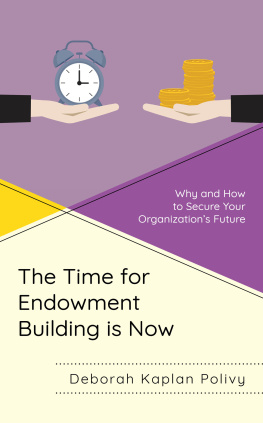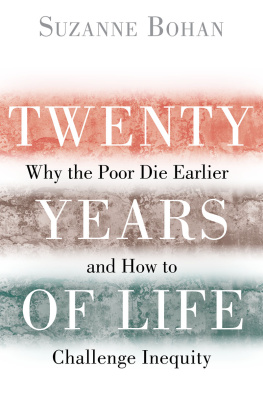The Time for Endowment
Building Is Now
The Time for Endowment
Building Is Now
Why and How to Secure Your
Organizations Future
Deborah Kaplan Polivy
ROWMAN & LITTLEFIELD
Lanham Boulder New York London
Published by Rowman & Littlefield
An imprint of The Rowman & Littlefield Publishing Group, Inc.
4501 Forbes Boulevard, Suite 200, Lanham, Maryland 20706
www.rowman.com
6 Tinworth Street, London SE11 5AL, United Kingdom
Copyright 2021 by Deborah Kaplan Polivy
All rights reserved. No part of this book may be reproduced in any form or by any electronic or mechanical means, including information storage and retrieval systems, without written permission from the publisher, except by a reviewer who may quote passages in a review.
British Library Cataloguing in Publication Information Available
Library of Congress Cataloging-in-Publication Data
Names: Polivy, Deborah Kaplan, 1947 author.
Title: The time for endowment building is now : why and how to secure your organizations future / Deborah Kaplan Polivy.
Description: Lanham : Rowman & Littlefield, [2021] | Includes bibliographical references and index. | Summary: Heres a concise, easy-to-understand guide to the objective of the philanthropic gift. This book emphasizes endowment building and eliminates the confusion built into the terms gift planning, legacy giving, and planned giving. It focuses on the ultimate goal of the giftto build the endowment of the respective not for profit organization.Provided by publisher.
Identifiers: LCCN 2020031173 (print) | LCCN 2020031174 (ebook) | ISBN 9781538137888 (cloth) | ISBN 9781538137895 (epub)
Subjects: LCSH: Endowments. | Nonprofit organizations.
Classification: LCC HV25 .P59 2021 (print) | LCC HV25 (ebook) | DDC 658.15/224dc23
LC record available at https://lccn.loc.gov/2020031173
LC ebook record available at https://lccn.loc.gov/2020031174
 TM The paper used in this publication meets the minimum requirements of American National Standard for Information Sciences Permanence of Paper for Printed Library Materials, ANSI/NISO Z39.48-1992.
TM The paper used in this publication meets the minimum requirements of American National Standard for Information Sciences Permanence of Paper for Printed Library Materials, ANSI/NISO Z39.48-1992.
For Gideon Abraham Tamuz
Its your turn!
Preface
The Time for Endowment Fundraising Really Is Now
Baby Boomers to advertisers: Weve got the money.
When I proposed this book, I was primarily concerned with why so many not-for-profit organizations do not actively pursue endowment contributions. Since then, which really is not so long ago, I have become increasingly compelled to write about the reasons they should engage in endowment building. These include the impact of the 2017 Tax Act on charitable giving and the impending and even current transfer of wealth by baby boomers. Some of this latter money could be captured by not-for-profit organizations were they to mobilize themselves to obtain it. Or, said another way, it is essential that charitable institutions pay attention to the wealth transfer and vigorously seek endowment gifts, and for many of those who have mature endowment funds, it is time to upgrade their endowment fundraising processes, procedures, and, most important, policies.
I have always been an advocate of endowment fundraising; it is necessary for the future vitality of small and mid-size charitable organizations. Even some veteran institutions that have sizable endowment funds need to take a look at the way in which they raise and use endowment monies if they, too, want to remain healthy over time. And yet so many organizations are just not paying attention to how they pursue endowment gifts, if in fact they even do, and to how they use the donations they receive especially in relation to unrestricted future contributions.
Organizations often do not actively pursue endowment gifts and/or think about how they ultimately expend them because their leadership is primarily concerned with meeting annual budgets. In addition, those organizations that are not seeking endowment donations, especially the small to medium-size ones, frequently do not do so because their leaders think that this kind of fundraising is expensive and difficult especially because of the language that is commonly associated with itplanned givingwhich is perceived as complicated. While these reasons are important impediments to endowment building, the time has come to overcome them and vigorously proceed with this effort.
The data on the impact of the 2017 Tax Act on charitable giving are still somewhat inconclusive except in relation to those people whose contributions were influenced by their ability to obtain income tax deductions.
These middle-class to middle-class, affluent people that Palmer cites include many of those baby boomers who will provide the greatest wealth transfer in U.S. history. It is estimated that $59 trillion will be transferred from 93.6 million American estates between 2007 and 2061.
The authors of the Boston College report from which these numbers come, A Golden Age of Philanthropy Still Beckons: National Wealth Transfer and Potential for Philanthropy Technical Report, conclude that a portion of these monies will be contributed to not-for-profit organizations if fundraisers and charitable causes continue their current level of effort to obtain charitable donations and bequests. However, they state, if their approach to fundraising becomes more effective, they have an opportunity to increase the amount that goes to charity well above our estimates.and especially the people at the older end of this age range. So, while my initial thought was to focus this book primarily on doing away with the impediments to endowment development, and it still is, the reasons to do so are incredibly compelling.
In spite of the necessity to mobilize ourselves to up the ante in the not-for-profit sector and invest some major resources in raising endowment monies, this subject is totally ignored in a several-page article in The Chronicle of Philanthropy entitled, Can the Boom Times Last? While the piece suggests countless ways to ensure that uncertainty about future giving is addressed through a list of fundraising techniques, it makes no mention of endowment building. It promotes such approaches as focusing on the biggest donors, technology, donor designation, mail appeals tailored to specific midlevel donors, peer-to-peer fundraising, identification of small, highly motivated niches of supporters and appeal[s] to their interests directly, targeted ads, and corporate partnerships. Endowment building is addressed tangentially at best by noting that some successful, large campaigns had obtained planned-gift pledges.
In other words, in spite of the very unique circumstances that we are living in, if this article from November 2019 in The Chronicle of Philanthropy is an example of current thinking in relation to endowment development, then the latter is not getting the attention it should nor that the authors of the Boston College report suggest. This is not to say that articles have not been published about building endowment funds. They have been and continue to be. However, their writers use the terminology of planned giving and/or focus on the creation of bequest programs. Neither of these is suitable to capture the amount of money that could be available if we were to widen our lens and change our language.
This book addresses these issues. The first part describes endowment development and how the complexity of the vernacular often gets in the way of pursuing the function especially on the part of those organizations that probably need it the most to survive. This is especially true if annual giving declines because of a changing economy and tax situation. In this section, I also describe the lack of consistency and often transparency across the not-for-profit sector in terms of how endowment gifts are handled especially in relation to realized, unrestricted contributions that primarily result from bequests or charitable gift annuities and trusts. I also ask a question that other people have thought about, too. Should we even be putting money away for the future since we have so many societal problems that could benefit from contributions today? In other words, is annual giving the way to go and the contemporary imperative?
Next page







 TM The paper used in this publication meets the minimum requirements of American National Standard for Information Sciences Permanence of Paper for Printed Library Materials, ANSI/NISO Z39.48-1992.
TM The paper used in this publication meets the minimum requirements of American National Standard for Information Sciences Permanence of Paper for Printed Library Materials, ANSI/NISO Z39.48-1992.